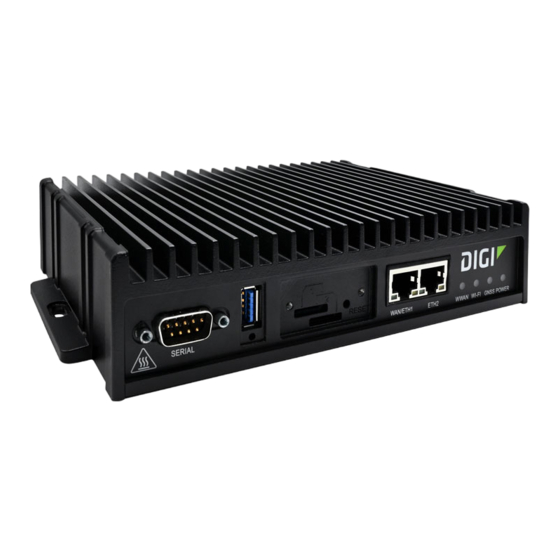
Digi TX40 Manuals
Manuals and User Guides for Digi TX40. We have 1 Digi TX40 manual available for free PDF download: User Manual
Digi TX40 User Manual (1150 pages)
Brand: Digi
|
Category: Network Router
|
Size: 18 MB
Table of Contents
-
TX40 Leds22
-
Wi-Fi22
-
GNSS Service23
-
Power23
-
Local Webui34
-
Learn more70
-
Interfaces71
-
Disable Surelink106
-
Delete a LAN195
-
DHCP Servers196
-
Bridging224
-
Serial Port236
-
Hotspot351
-
Hotspot Security353
-
Routing402
-
IP Routing403
-
Routing Services427
-
Dynamic DNS431
-
Vrrp436
-
Configure VRRP437
-
Configure VRRP440
-
Ipsec461
-
Ipsec Mode461
-
Ipsec Modes461
-
Authentication462
-
Openvpn525
-
Show GRE Tunnels571
-
L2Tp593
-
L2TP with Ipsec603
-
L2Tpv3 Ethernet605
-
Macsec611
-
Nemo613
-
Show NEMO Status618
-
Configure DNS648
-
Show DNS Server653
-
WAN Bonding654
-
SNMP Security666
-
Download Mibs671
-
Modbus Gateway707
-
System Time724
-
Install Python775
-
Python Modules781
-
Local Users851
-
Ldap877
-
Packet Filtering913
-
Web Filtering937
-
Downgrading970
-
Enable FIPS Mode992
-
Intelliflow1013
-
Enable Intelliflow1014
-
Create a Directory1032
-
Perform a Speedtest1041
-
View System Logs1046
-
View Event Logs1048
-
Clear Captured Data1074
-
Stop Ping Commands1076
-
Safety Warnings1083
-
English1083
-
Bulgarian--Български1083
-
Croatian--Hrvatski1084
-
French--Français1085
-
Greek--Ελληνικά1085
-
Hungarian--Magyar1086
-
Italian--Italiano1086
-
Latvian--Latvietis1087
-
Lithuanian--Lietuvis1088
-
Polish--Polskie1088
-
Slovak--Slovák1089
-
Slovenian--Esloveno1090
-
Spanish--Español1091
-
The Help Command1097
-
Available Commands1100
-
Use the Scp Command1101
-
Show Config1103
-
Show System1103
-
Show Network1103
-
Configuration Mode1106
-
The Revert Command1114
-
Analyzer Clear1121
-
Analyzer Save1121
-
Analyzer Start1121
-
Analyzer Stop1121
-
Cat1122
-
Clear Dhcp-Lease Mac1122
-
Container Create1122
-
Container Delete1122
-
Grep1123
-
Help1123
-
Mkdir1125
-
Modem at1125
-
Modem At-Interactive1125
-
Modem Firmware Check1125
-
Modem Firmware List1125
-
Modem Pin Change1127
-
Modem Pin Disable1127
-
Modem Pin Enable1128
-
Modem Pin Status1128
-
Modem Pin Unlock1128
-
Modem Puk Status1128
-
Modem Puk Unlock1129
-
Modem Reset1129
-
Modem Scan1129
-
Modem Sim-Slot1129
-
Monitoring1130
-
More1130
-
Ping1131
-
Poweroff1131
-
Reboot1131
-
Scp1133
-
Show Analyzer1133
-
Show Arp1133
-
Show Cloud1133
-
Show Config1134
-
Show Containers1134
-
Show Dhcp-Lease1134
-
Show Dns1134
-
Show Eth1134
-
Show Event1135
-
Show Hotspot1135
-
Show Ipsec1135
-
Show L2Tp Lac1135
-
Show L2Tp Lns1136
-
Show L2Tpeth1136
-
Show Location1136
-
Show Log1136
-
Show Manufacture1136
-
Show Modbus-Gateway1137
-
Show Modem1137
-
Show Mqtt1137
-
Show Nemo1137
-
Show Network1138
-
Show Ntp1138
-
Show Openvpn Client1138
-
Show Openvpn Server1138
-
Show Route1139
-
Show Scep-Client1139
-
Show Scripts1139
-
Show Serial1139
-
Show Surelink Ipsec1140
-
Show Surelink State1140
-
Show System1140
-
Show Usb1141
-
Show Version1141
-
Show Vrrp1141
-
Show Wan-Bonding1141
-
Show Web-Filter1141
-
Show Wifi Ap1142
-
Show Wifi Client1142
-
Show Wifi-Scanner1142
-
Speedtest1143
-
Ssh1144
-
System Backup1144
-
System Factory-Erase1145
-
System Find-Me1145
-
System Restore1146
-
System Script Start1147
-
System Script Stop1147
-
System Serial Save1147
-
System Serial Show1147
-
System Time Set1148
-
System Time Sync1148
-
System Time Test1148
-
Tail1149
-
Telnet1149
-
Traceroute1149
Advertisement
Advertisement
